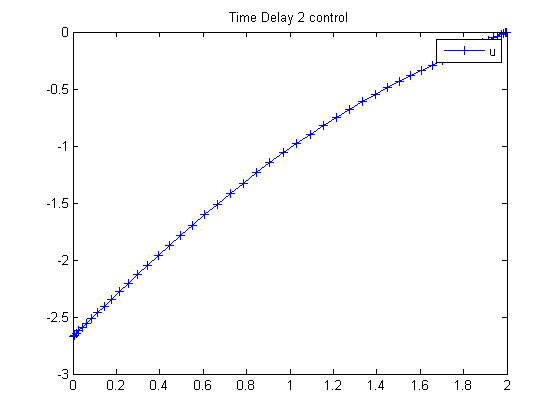Time Delay 2 (Approximate)
ITERATIVE DYNAMIC PROGRAMMING, REIN LUUS
8.3.2 Example 2
CHAPMAN & HALL/CRC Monographs and Surveys in Pure and Applied Mathematics
Linear time-delay system considered by Palanisamy et al.
Contents
Problem Formulation
Find u over t in [0; 2 ] to minimize

subject to:



A Taylor series expansion gives:

The initial condition are:
![$$ x(0) = [1 \ 0] $$](xtimeDelay2_approximate_eq23555.png)

% Copyright (c) 2007-2008 by Tomlab Optimization Inc.
Problem setup
toms t p = tomPhase('p', t, 0, 2, 50); setPhase(p); tomStates x1 x2 tomControls u % Initial guess x0 = {icollocate({x1 == 1; x2 == 0}) collocate(u == 0)}; % Boundary constraints cbnd = initial({x1 == 1; x2 == 0}); % ODEs and path constraints tau = 1; ceq = collocate({ dot(x1) == ((t+1).*x1+u)/(1+tau) dot(x2) == x1.^2+u.^2}); % Objective objective = final(x2);
Solve the problem
options = struct;
options.name = 'Time Delay 2 Appr.';
solution = ezsolve(objective, {cbnd, ceq}, x0, options);
t = subs(collocate(t),solution);
u = subs(collocate(u),solution);
Problem type appears to be: lpcon
===== * * * =================================================================== * * *
TOMLAB - Tomlab Optimization Inc. Development license 999001. Valid to 2010-02-05
=====================================================================================
Problem: --- 1: Time Delay 2 Appr. f_k 5.340734691399960700
sum(|constr|) 0.000000236393505091
f(x_k) + sum(|constr|) 5.340734927793465500
f(x_0) 0.000000000000000000
Solver: snopt. EXIT=0. INFORM=1.
SNOPT 7.2-5 NLP code
Optimality conditions satisfied
FuncEv 1 ConstrEv 31 ConJacEv 31 Iter 26 MinorIter 138
CPU time: 0.187500 sec. Elapsed time: 0.172000 sec.
Plot result
figure(1) plot(t,u,'+-'); legend('u'); title('Time Delay 2 control');
